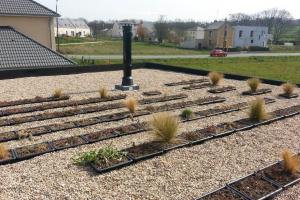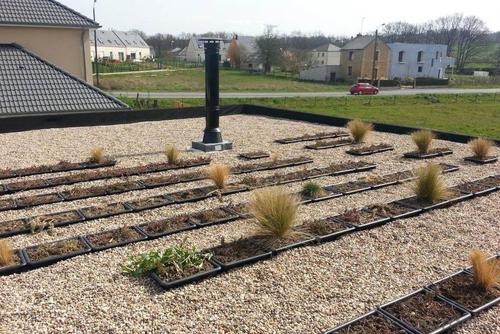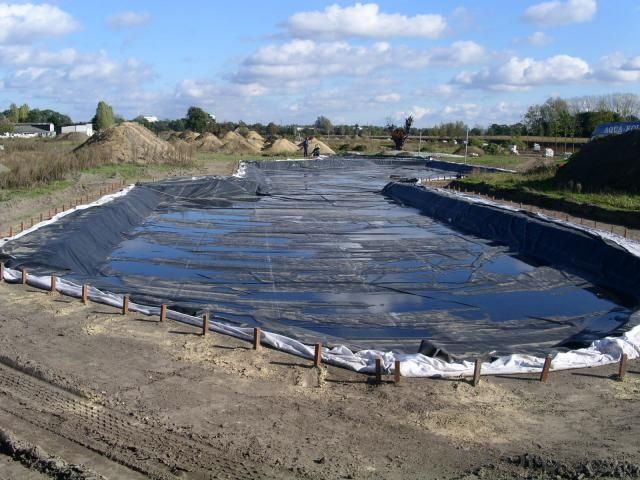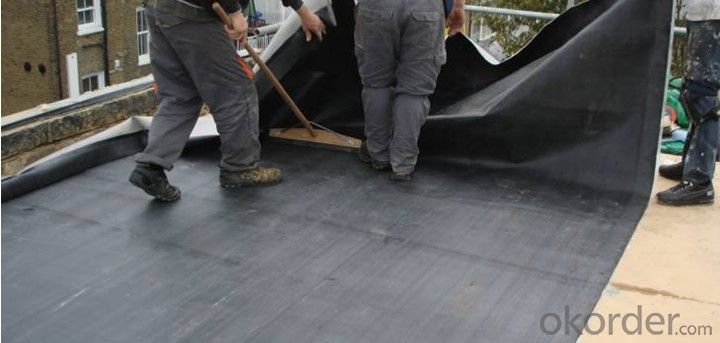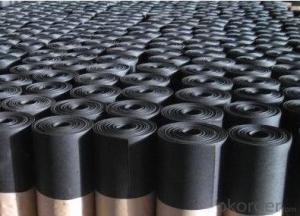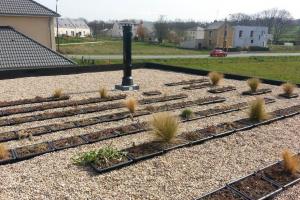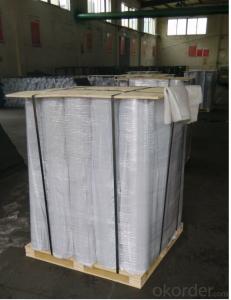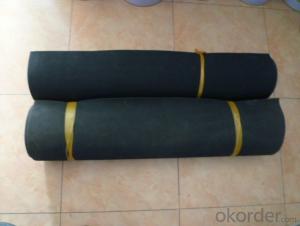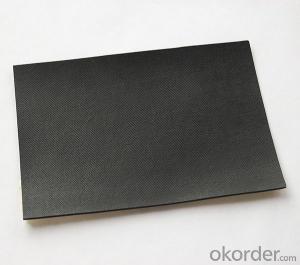EPDM Waterproofing Membrane for Crops Plant
- Loading Port:
- Shanghai
- Payment Terms:
- TT OR LC
- Min Order Qty:
- 50000 m²
- Supply Capability:
- 5000000 m²/month
OKorder Service Pledge
OKorder Financial Service
You Might Also Like
EPDM Waterproofing Membrane for Crops Plant
Description Of EPDM Waterproofing Membrane for Crops Plant:
This waterproof coiled material is of high elasticity with best performance among high polymer waterproof coiled material in the world.It is also the most typical one in the world.Waterproof coiled material made of ternary ethylenepropylene rubber of KINTOPbrand is produced with the use of the most advanced continuous extrusion and vulcanization technology and related equipments which are specially designed for production of such product.It is good in compactness,without bubble and performance difference in length and breadth.
Main Features of EPDM Waterproofing Membrane for Crops Plant:
1>Excellent anti-aging performance, service life up to 50 years
2>Working well with in -40°C to 100°C,it can be constructed with a single layer in ambient temperature.
3>Waterproofing on various kinds of underground project,industrial of civil buildings and structures.
4>high extension rate, high tensile strength, small size changes at heat treatment
5>Good plant roots penetrability resistance and can be made waterproofing layer of planting roof
6>Special modified molecular structure ,effectively resolving the current domestic and foreign glue
joint problem .
7>Good low temperature flexibility, and good performance of adapting to ambient temperature
changes.
8>Convenient application ,solid joint, no environment pollution
9>chemical corrosion Resistance, can be used for special occasions
Specifications of EPDM Waterproofing Membrane for Crops Plant:
Type | EPDM Rubber Waterproof Membrane | ||
Type | Vulcanized and Weldable | ||
Thickness | 1.2mm | 1.5mm | 2.0mm |
Weight(kg/m2) | 1.54-1.58 | 1.79-1.83 | 2.25-2.29 |
Size | 1.2m (width) * 20m (length)/roll. Weldable type could be 4m wide. | ||
Packing | 24㎡/roll, with plastic bag. (Weldable: 80㎡/roll) | ||
Usage | Roof, basement, pond, Lake, steel structure roofing, underground, tunnel, etc | ||
NO. | Item | Unit | Technical requirement | |
1 | Tolerance on size | Thickness | % | ±10 |
Width | % | ±1 | ||
length | % | Does not allow negative | ||
2 | Fracture tensile strength (normal temperature ) | Mpa | ≥7.5 | |
Fracture tensile strength(60 ℃) | Mpa | ≥2.3 | ||
3 | Breaking elongation,(normal temperature ) | % | ≥450 | |
Breaking elongation,(-20 ℃) | % | ≥200 | ||
4 | Tearing resistance | KN/m | ≥25 | |
5 | Impermeability | * | 0.3Mpa impermeable | |
6 | Bending at low temperature | °C | ≤-40 | |
7 | Elongation and contraction volume at heating | Elongation | mm | ≤2 |
contraction | mm | ≤4 | ||
8 | Hot air aging 80°CX168h | Fracture strength retention | % | ≥80 |
Rate of elongation at break | % | ≥70 | ||
9 | Alkaline (saturated Ca(OH)2 solution normal Temperature x2 168h ) | Fracture strength retention | % | ≥80 |
Rate of elongation at break | % | ≥80 | ||
10 | Ozone aging (40 degree by 168 hours ) | Elongation 40% , 500x10-2 | * | No Crack |
11 | Phytotron aging | Fracture strength retention | % | ≥80 |
Rate of elongation at break | % | ≥70 | ||
Applications of EPDM Waterproofing Membrane for Crops Plant:
Widely used in roofs, basement, toilet ,swimming pool, and all kinds of industry and civil building waterproofing, reservoir, vivicism, bridge, underground, tunnel and dam waterproofing ,especially to the keystone waterproofing projects which is durability, high corrosion resistance and easy deformation.
Construction Site of EPDM Waterproofing Membrane for Crops Plant:
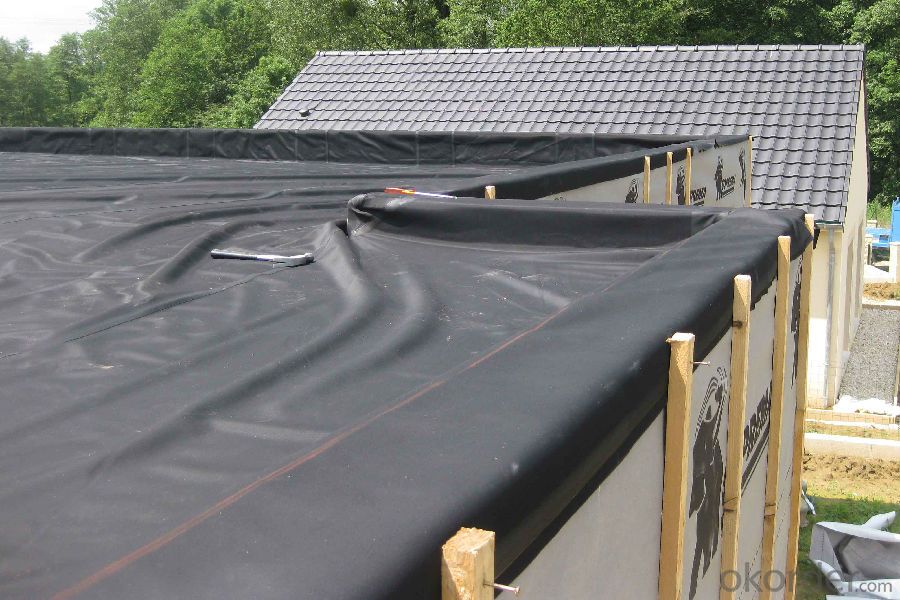


IMages of EPDM Waterproofing Membrane for Crops Plant:
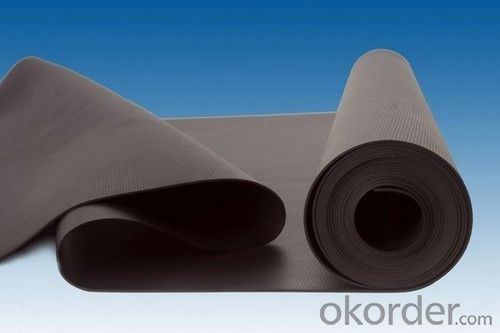



FAQ of EPDM Waterproofing Membrane for Crops Plant:
1. What are we supplying?
We are specialized in producing Colorful Asphalt Roof Shingle, SBS/APP modified bitumen waterproof membrane, Self adhesive bitumen waterproof membrane, PVC waterproofing membrane, EPDM rubber roofing membrane, Single Component Polyurethane Waterproof Coating, and Spray Polyurea Waterproof Coating
.
2. How Many years experience do we have?
We have been exported to more than 20 countries in the past 15 years.
3. How long do we usually reply your request?
We always reply our customer within 24 hours.
- Q: Can a waterproofing membrane be applied to both interior and exterior surfaces?
- Both interior and exterior surfaces can benefit from the application of a waterproofing membrane. Its main objective is to safeguard against water infiltration and shield the underlying surfaces. Regardless of whether it is used indoors or outdoors, the membrane serves the same purpose of establishing a barrier against moisture. Basements and crawl spaces commonly utilize interior waterproofing membranes to prevent water from seeping into the building interior. On the other hand, exterior waterproofing membranes are typically applied to the outside walls and foundations to guard against water penetration from rain, groundwater, and other external sources. Both types of membranes are engineered to be long-lasting, adaptable, and water-resistant, ensuring the durability and structural soundness of the surfaces they are applied to.
- Q: Can a waterproofing membrane be used in chemical or hazardous environments?
- Indeed, a waterproofing membrane proves effective in chemical or hazardous surroundings. Its purpose is to serve as a barrier against water, moisture, and other liquids, including chemicals and hazardous substances. Typically, these membranes are constructed from chemical-resistant materials like polyurethane, PVC, or modified bitumen. This composition ensures their durability and ability to withstand exposure to various chemicals without harm. Nevertheless, it is vital to choose a waterproofing membrane specifically designed for chemical or hazardous environments to guarantee compliance with necessary requirements and standards. Moreover, proper installation and maintenance play a crucial role in ensuring the long-lasting effectiveness of the waterproofing membrane in such settings.
- Q: Can a waterproofing membrane be used on roofs with rooftop gardens?
- Indeed, rooftops with gardens can benefit greatly from the utilization of a waterproofing membrane. Employing a waterproofing membrane is strongly advised as it shields the foundational framework from harm caused by water. Given that a rooftop garden contributes additional weight and moisture to the roof, it is imperative to have a reliable waterproofing system in place to avert leaks and guarantee the roof's durability. The waterproofing membrane serves as a safeguard against water infiltration, effectively maintaining dry conditions for both the rooftop garden and the underlying structure.
- Q: Can a waterproofing membrane be used on roofs or only on vertical surfaces?
- Both roofs and vertical surfaces can benefit from the use of a waterproofing membrane. It is a common practice to utilize this membrane to safeguard roofs against water-related harm. Specifically designed as a barrier against water infiltration, roofing membranes guarantee a dry and leak-free structure. These membranes are applied to the roof's surface, forming a protective layer that prevents water from seeping through. In a similar manner, waterproofing membranes can also be employed on vertical surfaces, such as walls, to prevent water ingress and safeguard the underlying structure. The primary objective of a waterproofing membrane is to establish a watertight seal, regardless of whether it is used on a horizontal or vertical surface. Therefore, whether it is a roof or a vertical wall, a waterproofing membrane is an effective solution for shielding against water damage.
- Q: Are waterproofing membranes resistant to chemical solvents?
- Waterproofing membranes are generally capable of withstanding chemical solvents. They are designed to endure exposure to different chemicals, including solvents. These membranes are formulated to create a barrier against moisture and safeguard against damage caused by chemical contact. The ability to resist chemical solvents is a crucial characteristic of waterproofing membranes, as it guarantees their durability and effectiveness in various applications like construction, roofing, and below-grade waterproofing. However, it is important to mention that the specific resistance of a waterproofing membrane to chemical solvents may differ based on the type and brand of membrane used. Therefore, it is always advisable to refer to the manufacturer's guidelines for detailed information on chemical resistance.
- Q: Can a waterproofing membrane be used in high-rise buildings?
- Yes, a waterproofing membrane can be used in high-rise buildings. In fact, it is highly recommended to incorporate a waterproofing system in high-rise buildings to protect them from the damaging effects of water infiltration. Waterproofing membranes are designed to provide a barrier against water ingress, preventing leaks and moisture damage to the structure. They are commonly used on roofs, basements, foundations, and other areas that are exposed to water or moisture. The selection of the appropriate waterproofing membrane will depend on various factors such as the specific building design, construction materials, and environmental conditions. It is important to consult with experienced waterproofing professionals to determine the most suitable membrane system for a high-rise building to ensure long-term protection against water-related issues.
- Q: Can a waterproofing membrane be used in conjunction with roofing materials?
- Yes, a waterproofing membrane can be used in conjunction with roofing materials. In fact, it is commonly used to provide an additional layer of protection against water infiltration and to enhance the overall waterproofing capabilities of the roof.
- Q: Can a waterproofing membrane be used in foundations?
- Yes, a waterproofing membrane can be used in foundations. In fact, it is often recommended to install a waterproofing membrane in foundations to prevent water infiltration and potential damage to the structure. The membrane is typically applied to the exterior walls of the foundation and acts as a barrier against water penetration. It helps to keep the foundation dry and protects it from hydrostatic pressure, which can cause cracks and leaks. Additionally, a waterproofing membrane can also prevent moisture buildup, mold growth, and other issues related to water damage. Overall, using a waterproofing membrane in foundations is an effective and reliable method to ensure the long-term durability and stability of a building.
- Q: Does a waterproofing membrane prevent water damage to building materials?
- Yes, a waterproofing membrane is designed to create a barrier that prevents water from seeping into building materials, thus effectively preventing water damage.
- Q: Are waterproofing membranes resistant to sewage?
- Waterproofing membranes exhibit resistance towards sewage, as they are tailor-made and produced to serve as a shield against diverse liquids, including sewage. Crafted from robust materials, these membranes possess the capability to endure sewage exposure and prevent any leakage or seepage. By establishing a safeguarding layer, waterproofing membranes effectively ward off sewage intrusion and safeguard the integrity of the underlying structures. This resistance to sewage renders waterproofing membranes a highly efficient remedy for locales susceptible to sewage backup or elevated moisture levels, such as basements, bathrooms, and water treatment facilities.
Send your message to us
EPDM Waterproofing Membrane for Crops Plant
- Loading Port:
- Shanghai
- Payment Terms:
- TT OR LC
- Min Order Qty:
- 50000 m²
- Supply Capability:
- 5000000 m²/month
OKorder Service Pledge
OKorder Financial Service
Similar products
Hot products
Hot Searches
Related keywords
